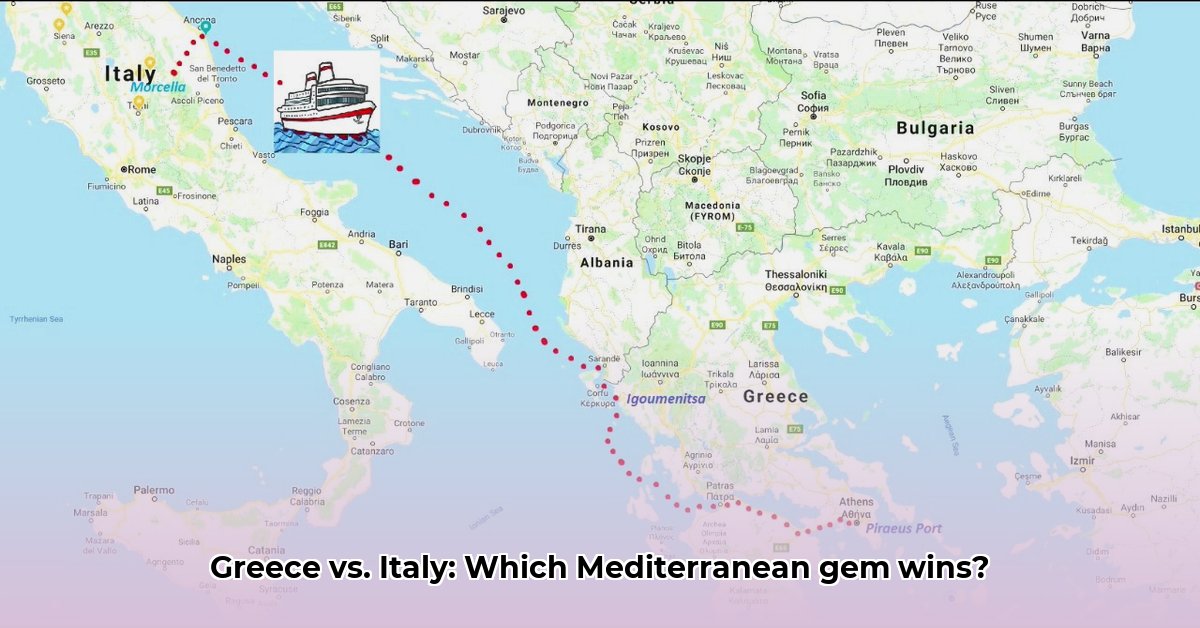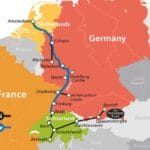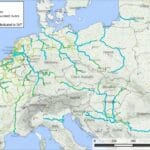Picture this: you’re flipping through a travel magazine, gazing at stunning photos of sun-drenched Italian villages clinging to hillside slopes and the sparkling turquoise waters surrounding Greek islands. Both countries are Mediterranean, right? So, you might think they must be pretty similar geographically. Think again! While both share the same sunny sea, Italy and Greece offer wildly different landscapes. Italy’s a solid “boot” kicking its way down into the Mediterranean, while Greece is a scattered archipelago of islands and a rugged mainland. This article will take you on a visual journey using maps and descriptions to compare these fascinating countries, exploring everything from their mountainous backbones and dramatic coastlines to the unique ways their geography has shaped their cultures and economies. For a visual representation of Italy’s flag, check out this link: Italian flag details. Get ready to discover the surprising contrasts and unexpected similarities that define these two Mediterranean gems.
Italy and Greece: A Geographical Overview
Italy and Greece, both bathed in the Mediterranean sun, present a captivating study in geographical contrasts. While sharing a warm Mediterranean climate, their landscapes differ significantly, influencing their history, culture, and economy. Like comparing a hearty pasta dish to a vibrant souvlaki platter – both are distinctly Mediterranean yet offer unique flavors.
Shape and Size: The Boot vs. The Archipelago
Italy’s recognizable “boot” shape, a peninsula extending into the Mediterranean, stands in stark contrast to Greece’s fragmented structure. Italy is a unified landmass, while Greece is an archipelago of islands combined with a mainland. This fragmentation has deeply shaped Greece’s identity, with each island developing a distinct regional culture. The sprawling nature of Greece’s geography contrasts with Italy’s more compact form. This difference impacts everything from transportation infrastructure to cultural cohesion.
Topography: Mountains and Plains vs. Rugged Peaks
Italy boasts the Apennine Mountains, which run down its spine, but it also has significant plains like the Po Valley. Greece, however, is dominated by mountains, creating a dramatic landscape where peaks plunge into the Aegean, Ionian, and Mediterranean Seas. This rugged terrain has profoundly shaped Greece’s development, influencing its agriculture, settlement patterns, and even its political organization. The contrast is striking on any map: Italy, a mix of mountains and plains; Greece, a land sculpted by mountains and sea.
Coastlines: Smooth Curves vs. Intricate Laces
Both countries possess extensive coastlines, vital to their economies and cultures. However, the nature of these coastlines differs significantly. Italy’s coastline is long, but relatively smooth. Greece, with its numerous islands, boasts a highly intricate coastline, a labyrinth of bays, inlets, and harbors. This has fostered a strong maritime tradition and shaped the development of countless coastal communities. Imagine the difference: Italy’s coastline, a smooth brushstroke; Greece’s, a delicate lacework.
Climate: Mediterranean Warmth with Regional Variations
The Mediterranean climate – hot, dry summers and mild, wet winters – is a shared characteristic. Yet, regional variations add nuance to each country’s climate. Italy, influenced by the Alps in the north, experiences a broader range of temperatures, transitioning from cooler northern climates to warmer southern conditions. Greece, while generally Mediterranean, experiences variations based on elevation and island microclimates. Some islands are markedly drier than others, adding to the diversity.
Volcanic Activity: Echoes of Fire
Both Italy and Greece share a history of volcanic activity. Mount Vesuvius, a symbol of Italy, famously destroyed Pompeii. Greece’s Santorini, with its stunning caldera, is another testament to volcanic forces. These events have left their mark on the land, culture, and mythology of both countries. The ongoing volcanic activity serves as a reminder of the dynamic geological forces shaping these regions.
Biodiversity: A Mediterranean Tapestry
Both countries are biodiversity hotspots. From the fertile Po Valley to the drier south, Italy supports a variety of ecosystems. Greece, with its many islands, fosters unique flora and fauna found nowhere else. The isolated nature of these islands has allowed unique species to evolve, creating a rich tapestry of life.
Impact on Human Settlements: Land Shapes Life
Geography has profoundly influenced human settlement patterns. Italy’s fertile plains fostered large-scale agriculture and the growth of powerful cities. Greece’s mountainous terrain, in contrast, supported smaller, more self-sufficient communities. These distinct geographies shaped societal structures and political systems throughout their history, demonstrating how the landscape shapes human societies.
Navigating the Seas: Ports and Maritime Influence
Both Italy and Greece have a long and rich maritime history, deeply influenced by their access to the Mediterranean Sea. Italy, with its strategic location and longer, less-fragmented coastline on its mainland, developed major port cities like Genoa, Venice, and Naples. These ports became centers of trade, connecting the East and West and fueling economic growth. Greece, with its thousands of islands, developed a maritime culture spread across numerous smaller ports and harbors. Its seafaring tradition is ancient, and its islands were key stopping points for trade throughout the Aegean and Mediterranean.
Agriculture and Land Use: Farming the Landscape
Italy’s extensive plains, particularly in the Po Valley, allowed for the development of large-scale agriculture, focusing on crops like wheat, olives, and grapes. This agricultural productivity supported a larger population and contributed significantly to Italy’s economy. In Greece, the mountainous terrain limited large-scale farming but encouraged the cultivation of specific crops suited to the local microclimates. Olive groves are prevalent, and vineyards thrive on the hillsides. The limited arable land has shaped Greek agricultural practices, emphasizing efficiency and the use of terraced farming.
Tourism: A Climate for Visitors
Both countries benefit significantly from tourism, drawn by their Mediterranean climate, rich history, and cultural attractions. Italy’s famous cities like Rome, Florence, and Venice attract millions of visitors each year. The diverse landscape, from the Alps to the Amalfi Coast, offers a wide range of tourist experiences. Greece’s islands, ancient ruins, and stunning beaches make it a popular destination. The mild climate and beautiful scenery attract tourists seeking relaxation, adventure, and cultural immersion.
Conclusion: Two Sides of the Mediterranean Coin
The comparison reveals the unique geographical identities of Italy and Greece, highlighting how their landscapes have shaped their respective histories, cultures, and economies. While both share a Mediterranean heritage, their distinct geographies have led to different paths of development. Exploring the nuances of climate variations, volcanic history, and biodiversity further enriches our understanding of these fascinating countries.
How Do Italy and Greece’s Differing Geographical Features Impact Their Respective Economies?
Let’s embark on a geographical journey, comparing and contrasting Italy and Greece. Both bask in the Mediterranean sun, but their landscapes tell vastly different stories—stories that profoundly shape their economies.
Shape and Size: A Tale of Two Peninsulas
Italy, a single, elongated “boot,” contrasts sharply with Greece’s scattered archipelago. This difference in shape dramatically influences infrastructure development and internal trade. Italy’s continuous landmass facilitated constructing efficient transportation networks, boosting internal trade and economic integration. Greece’s dispersed geography, however, presents logistical challenges, increasing transport costs and potentially hindering economic unification. How do these differences manifest economically?
Topography: Mountains and Plains, A Foundation for Prosperity or Struggle
Italy’s Apennines, while significant, offer fertile plains interspersed between the mountain ranges. These plains became cradles of agriculture and urbanization. Greece, in contrast, is a land of rugged mountains, extensive island chains, and less extensive plains. This rugged landscape has historically limited the extent of arable land and the ease of population movement. This geographical reality has implications for everything from agricultural output to the development of major cities. Did the fertile plains of Italy contribute to a more robust agricultural base compared to Greece’s predominantly mountainous terrain?
Coastlines: Seas of Opportunity
Both nations boast extensive coastlines, crucial for maritime trade. However, the nature of those coastlines differs. Italy’s relatively less-fragmented coastline facilitated the development of larger ports and facilitated trade with other Mediterranean nations and the broader world. Greece’s numerous islands, while enriching its culture and tourism industry, created a more complex, decentralized maritime commercial structure. Consider how this difference shaped the development of their respective navies and their overall reach in the region.
Climate and Agriculture: Varied Terrains, Varied Yields
While both countries share a Mediterranean climate, regional variations exist due to altitude and proximity to the sea. Italy’s more extensive plains allow for large-scale agricultural production. Greece’s diverse terrain, including mountainous regions and islands, supports a range of microclimates, leading to a greater variety of crops, but often on a smaller scale. How did these climatic differences influence agricultural specialization and economic output in each nation?
Volcanic Activity: A Double-Edged Sword
Mount Vesuvius in Italy, a destructive force, also enriched surrounding soils, contributing to agricultural productivity in the region. Greece’s volcanic activity on islands like Santorini also significantly affected their history, but not in the same way. Consider how both countries leveraged or managed their volcanic landscapes from an economic standpoint.
Biodiversity: Nature’s Bounty
The differing terrains support distinct ecosystems. Italy’s diverse landscapes from the Alps to the Mediterranean support a wide range of flora and fauna, influencing activities like forestry and tourism. Greece’s islands, each with their unique biodiversity, created a diverse mosaic of natural resources. Did the presence of varying ecosystems bring economic diversification to both countries, or did the differences limit specialization?
Infrastructure and Transportation: Connecting the Land
Italy, with its more unified geography, has developed an extensive network of highways, railways, and airports, facilitating the movement of goods and people throughout the country. This robust infrastructure supports manufacturing, trade, and tourism. Greece faces significant challenges in developing a cohesive transportation network due to its fragmented
- SYBAU See You Baby Meaning: Gen Z Slang Evolves - July 1, 2025
- Unlock Your Inner Youth: Lifestyle Secrets for a Vibrant Life - July 1, 2025
- Decode SYBAU Meaning: Gen Z Slang Explained - July 1, 2025






